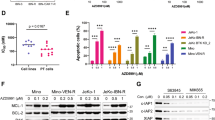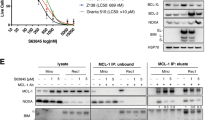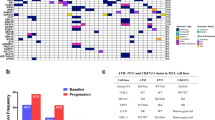Abstract
Signature abnormalities in the cell cycle and apoptotic pathway have been identified in mantle cell lymphoma (MCL), affording the opportunity to develop targeted therapies. In this study, we tested a novel class of kinase inhibitors, styryl sulfones, which differ from prior cell cycle inhibitors in that they are not related to purines or pyrimidines. We observed that two closely related compounds, ON013100 and ON01370, altered the growth and cell cycle status of MCL lines and potently inhibited the expression of several important molecules, including cyclin-dependent kinase4, p53, mouse double minute 2 (MDM2), and cyclin D as well as increased cyclin B expression. Using both terminal deoxy transferase uridine triphosphate nick end-labelling and poly ADP-ribose polymerase assays, we found that these compounds caused apoptosis in MCL cells. In addition, using molecular analyses, we observed the modulation of caspase-3 activity but not the expression of B-cell lymphoma family molecules. Next, we investigated the cytotoxicity of the MCL lines upon treatment with styryl sulfone compounds in combination with other currently used chemotherapeutic agents, such as doxorubicin (DOX) or vincristine (VCR). We found that the combination of DOX plus styryl sulfone or VCR plus styryl sulfone increased cytotoxicity by one log scale, compared with the single styryl sulfone compound. Thus, styryl sulfones alone, or in combination with chemotherapeutic agents, present attractive opportunities for new drug development in MCL.
This is a preview of subscription content, access via your institution
Access options
Subscribe to this journal
Receive 50 print issues and online access
$259.00 per year
only $5.18 per issue
Buy this article
- Purchase on Springer Link
- Instant access to full article PDF
Prices may be subject to local taxes which are calculated during checkout








Similar content being viewed by others
References
Bosch F, Jares P, Campo E, Lopez-Guillermo A, Piris MA, Villamor N et al. (1994). PRAD-1/cyclin D1 gene overexpression in chronic lymphoproliferative discoders: a highly specified marker of mantle cell lymphoma. Blood 84: 2725–2732.
Boutros R, Byrne JA . (2005). D53 (TPD52L1) is a cell cycle-regulated protein maximally expressed at the G2-M transition in breast cancer cells. Exp Cell Res 310: 152–162.
Braday SC, Allan LA, Clarke PR . (2005). Regulation of caspase 9 through phosphorylation by protein kinase C zeta in response to hyperosmotic stress. Mol Cell Biol 25: 10543–10555.
Brauns SC, Dealtry G, Milne P, Naude R, Van de Venter M . (2005). Caspase-3 activation and induction of PARP cleavage by cyclic dipeptide cyclo(Phe-Pro) in HT-29 cells. Anticancer Res 25: 4197–4202.
Campo E, Raffeld M, Jaffe ES . (1999). Mantle cell lymphoma. Semin Hematol 36: 115–127.
Chiarle R, Budel LM, Skolnik J, Fizzera G, Chilosi M, Corato A et al. (2000). Increased proteasome degradation of cyclin-dependent kinase inhibitor p27 is associated with a decreased overall survival in mantle cell lymphoma. Blood 95: 619–626.
Choi S, Singh SV . (2005). Bax and Bak are required for apoptosis induction by sulforaphane, a cruciferous vegetable-derived cancer chemopreventive agent. Cancer Res 65: 2035–2043.
Crowe DL, Sinha UK . (2005). P53 apoptotic response to DNA damage dependent on bcl2 but not bax in head and neck squamous cell carcinoma lines. Head Neck 21: 15–23.
Dash BC, El-Deiry WS . (2005). Phosphorylation of p21 in G2/M promotes cyclin B-Cdc2 kinase activity. Mol Cell Biol 25: 3364–3387.
de Boer CJ, van Krieken JH, Kluin-Nelemans HC, Kluin PM, Schuuring E . (1995). Cyclin D1 messenger RNA overexpression as a marker for mantle cell lymphoma. Oncogene 10: 1833–1840.
de Leeuw RJ, Davies JJ, Rosenwals A, Bbb G, Gascoyne RD, Dyer MJS et al. (2004). Comprehensive whole genome array CGH profiling of mantle cell lymphoma model genomes. Hum Mol Genetics 13: 1827–1837.
Elias B, Laine A, Ronai Z . (2005). Phosphorylation of MdmX by CDK2/Cdc2(p34) is required for nuclear export of Mdm2. Oncogene 24: 2574–2579.
Ely S, Di Liberto M, Niesvizky R, Baughn LB, Cho HJ, Hatada EN et al. (2005). Mutually exclusive cyclin-dependent kinase 4/cyclin d1 and cyclin-dependent kinase 6/cyclin d2 pairing inactivates retinoblastoma protein and promotes cell cycle dysregulation in multiple myeloma. Cancer Res 15: 11345–11353.
Ferbabdez V, Hartmann E, Ott G, Campo E, Rosenwald A . (2005). Pathogenesis of mantle-cell lymphoma: All oncogenic roads lead to dysregulation of cell cycle and DNA damage response pathways. J Clin Onc 23: 6364–6369.
Fukuda T, Asai N, Enomoto A, Takahashi M . (2005). Activation of c-Jun amino-terminal kinase by GDNF induces G2/M cell cycle delay linked with actin reorganization. Genes Cells 10: 655–663.
Gumireddy K, Pamana Reddy MV, Cosenza SC, Boominathan R, Baker SJ, Papathi N et al. (2005). ON01910, a non-ATP-competitive small molecule inhibitor of PIK1, is a potent anticancer agent. Cancer Cell 7: 275–286.
Hunter T, Pines J . (1994). Cyclins and cancer: II. Cyclin D and CDK inhibitors come of age. Cell 79: 573–582.
Kimby E, Wallblom A, Sander B . (2005). Mantle cell lymphoma: Chromosomal aberrations, proliferation and cyclin D1 transcripts in relation to clinical outcome. Annals of Oncology 9th International Conference on Malignant Lymphoma 16 (Supplement 5): v168 (#446).
Kozar K, Ciemerych MA, Rebel VI, Shigematsu H, Zagozdzon A, Sicinska E . (2004). Mouse development and cell proliferation in the absence of D-cyclins. Cell 118: 477–491.
Lardelli P, Bookman MA, Sundeen J, Longo DL, Jaffe ES . (1990). Lymphocytic lymphoma of intermediate differentiation: morphologic and immunophenotypic spectrum and clinical correlation. Am J Surg Pathol 14: 752–763.
Lee KH, Rudolph KL, Ju YJ, Greenberg RA, Cannizzaro L, Chin L et al. (2001). Telomere dysfunction alters the chemotherapeutic profile of transformed cells. Pro Natl Acad Sci USA 98: 3381–3386.
Martin SA, Ouchi T . (2005). BRCA1 phosphorylation regulates caspase-3 activation in UV-induced apoptosis. Cancer Res 65: 100657–100662.
Nevins JR, DeGregori J, Jakoi L, Leone G . (1997). Functional analysis of E2F transcription factor. Methods Enzymol 283: 205–219.
Nozoe T, Takahashi I, Baba H, Maehara Y . (2005). Relationship between intracellular localization of p34cdc2 protein and differentiation of esophageal squamous cell carcinoma. J Cancer Res Clin Oncol 131: 179–183.
Park IW, Ulrich CK, Schoenberger E, Ganju RK, Groopman JE . (2001). HIV-1 Tat induces microvascular endothelial apoptosis through caspase activation. J Immunol 167: 2766–2771.
Rizzatti EG, Falcao RP, Panepucci RA, Proto-Siqueira R, Anselmo-Lima WT, Okamoto OK et al. (2005). Gene expression profiling of mantle cell lymphoma cells reveals aberrant expression of genes from the PI3K-AKT, WNT and TGF-beta signaling pathways. Br J Haematol 130: 516–526.
Rosenwald A, Wright G, Wiestner A, Chan WC, Connors JM, Campo E et al. (2003). The proliferation gene expression signature is a quantitative integrator of oncogenic events that predicts survival in mantle cell lymphoma. Cancer Cell 3: 185–197.
Serrano M, Hannon GJ, Beach D . (1993). A new regulatory motif in cell-cycle control causing specific inhibition of cyclin D/CDK4. Nature (London) 366: 704–707.
Sherr CJ, Roberts JM . (1999). CDK inhibitors: positive and negative regulators of G1-phase progression. Genes Dev 13: 1501–1512.
Sherr CJ, Roberts JM . (2004). Living with or without cyclins and cyclin-dependent kinases. Genes Dev 18: 2699–2711.
Swerdlow SH, Williams ME . (2002). From centrocytic to mantle cell lymphoma: a clinicopathologic and molecular review of 3 decades. Hum Pathol 33: 7–20.
Tan J, Zhuang L, Leong HS, Iyer NG, Liu ET, Yu Q . (2005). Pharmacologic modulation of glycogen synthase kinase-3beta promotes p53-dependent apoptosis through a direct Bax-mediated mitochondrial pathway in colorectal cancer cell. Cancer Res 65: 9012–9020.
Tiemann M, Schrader C, Lkapper W, Dreyling MH, Campo E, Norton A et al. (2005). Histopathology, cell proliferation indices and clinical outcome in 304 patients with mantle cell clymphoma (MCL): a clinicopathological study form the European MCL Network. Br J Haematol 131: 29–38.
Witzig TE . (2005). Current treatment approaches for mantle-cell lymphoma. J Clin Onc 23: 6409–6414.
Yamasaki L . (1998). Growth regulation by the E2F and DP transcription factor families. Results Probl Cell Differ 22: 199–227.
Zucca E, Roggero E, Pinotti G, Pedrinis E, Capella C, Venco A et al. (1995). Patterns of survival in mantle cell lymphoma. Ann Oncol 6: 257–262.
Acknowledgements
This work was supported by a charitable contribution from Henryk and Rochelle Schwarz. E Premkumar Reddy was supported by grant CA109820.
Author information
Authors and Affiliations
Corresponding author
Rights and permissions
About this article
Cite this article
Park, IW., Reddy, M., Reddy, E. et al. Evaluation of novel cell cycle inhibitors in mantle cell lymphoma. Oncogene 26, 5635–5642 (2007). https://doi.org/10.1038/sj.onc.1210350
Received:
Revised:
Accepted:
Published:
Issue Date:
DOI: https://doi.org/10.1038/sj.onc.1210350
Keywords
This article is cited by
-
Preclinical Pharmacokinetic and Pharmacodynamic Evaluation of Novel Anticancer Agents, ON01910.Na (Rigosertib, Estybon™) and ON013105, for Brain Tumor Chemotherapy
Pharmaceutical Research (2012)
-
Konzept der prädiktiven Molekularpathologie
Der Onkologe (2011)
-
Styryl sulfonyl compounds inhibit translation of cyclin D1 in mantle cell lymphoma cells
Oncogene (2009)
-
Genetic and molecular pathogenesis of mantle cell lymphoma: perspectives for new targeted therapeutics
Nature Reviews Cancer (2007)



